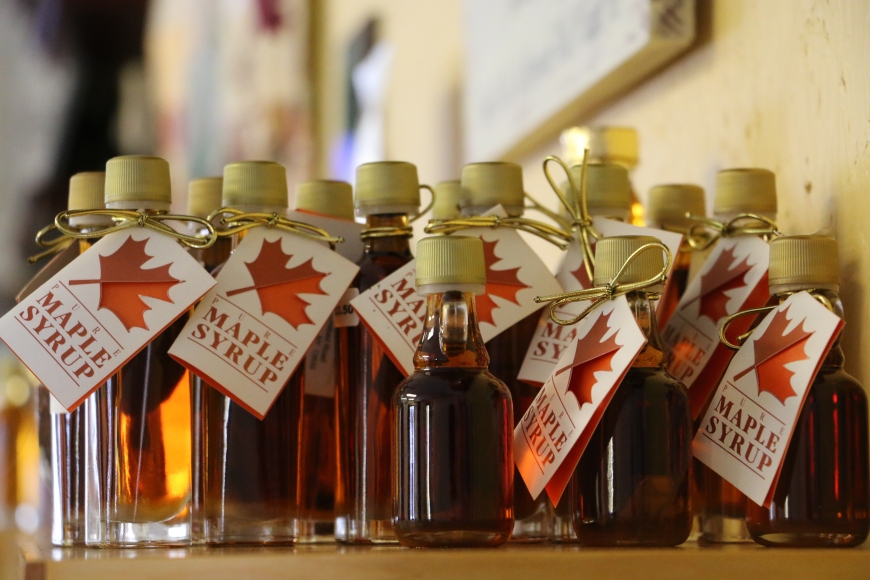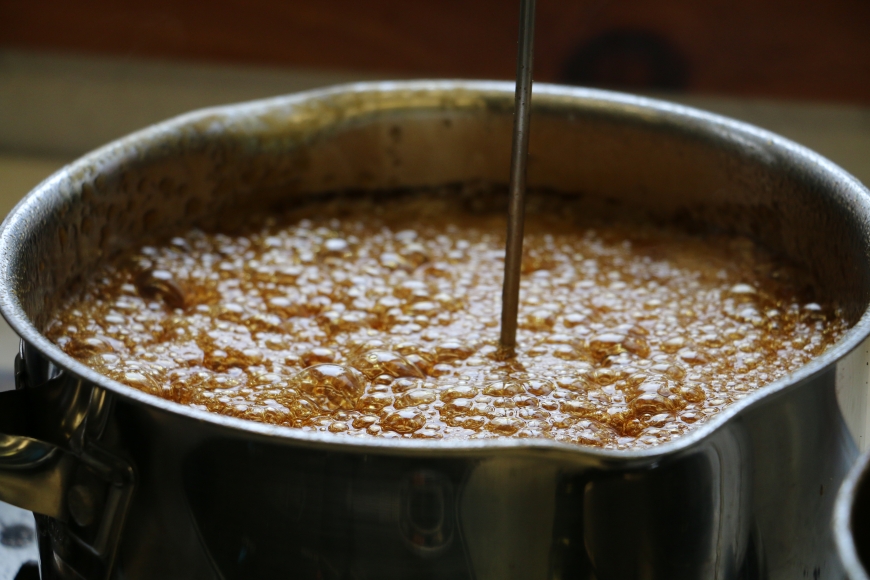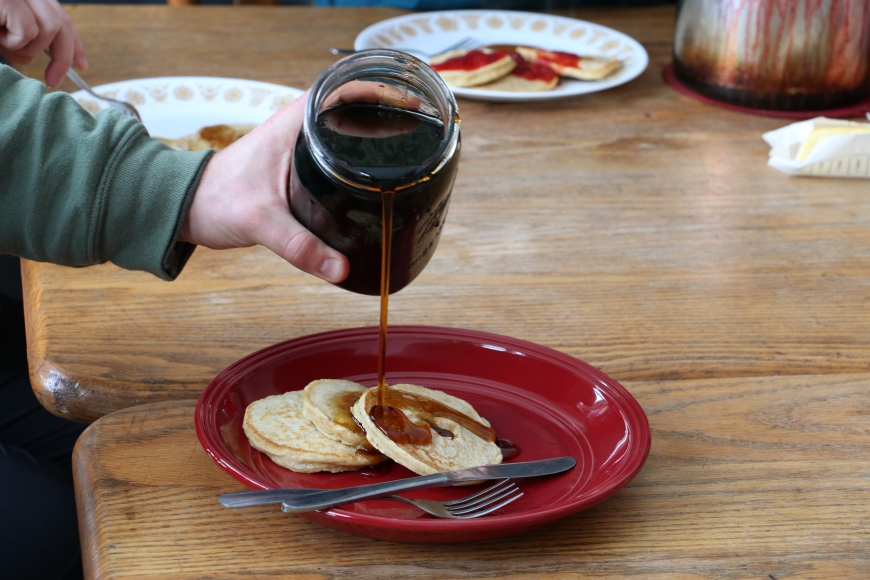


Maple syrup from Orebed Sugar Shack, Photo by: Imman Merdan
Boiling sap into maple sugar at Orebed Sugar Shack, Photo by: Imman Merdan
Syrup from the Cornell Cooperative Extension, Photo by: Justin Dalaba



Maple Syrup: A Timely Tradition
Don't miss New York State Maple Weekends, March 23-24th and 30-31, 2019! Visit https://mapleweekend.nysmaple.com/ for details.
Maple syrup and maple sugar production have deep roots in the North Country, and for some it has been a way to make a living for generations. Imagine for a moment how the maple syrup on your pancakes made it to the table. If you’ve ever had the opportunity to see what goes into the process, you’ll surely understand why the real syrup costs a bit more than the artificial stuff. As any experienced maple producer would attest, it’s a labor of love that is absolutely worth it.
Jeff Jenness of Orebed Sugar Shack has been producing in Dekalb for a little over 25 years. Both he and his wife Lori started with their parents, who used to run syrup production with horses. “There’s four generations of us here on the weekends that have been doing maple syrup for 70 years,” he says. “I have a lot of help because it’s a family thing; you can’t do it alone. I try to do most of the syrup myself, then we store it in a cold room in stainless steel until we’re ready to either bottle it, make it into candy, cream, sugar, candy-coated dog bones or maple cotton candy.”
Maple syrup also runs in the family at Hurlbut’s Maple in Canton. Andy Hurlbut started at about the age of 6 with his father and grandfather, and then decided he wanted to earn some money for college, so he began producing commercially in 1995. He and his wife now tap about 2500 trees among 3 sugar bushes covering 100 acres. Each year, Hurlbut’s produces an estimated 100,000 gallons of sap, which converts to about 2000 to 2500 gallons of syrup. This means that to produce a gallon of maple syrup, it can take between 40 and 50 gallons of sap.

Ideal conditions for sap flow are warm days and cold nights, with temperatures ranging above and below freezing by 5-10 degrees each day. “That up and down cycle every day produces maple sap that has 2 to 4 percent sugar, which you then boil on a stove or evaporator to drive out a majority of the water and then you’re left with about 66 percent sugar,” as Andy Hurlbut explains.
Both the Jenness and the Hurlbut families operate on a larger scale with the most up-to-date equipment to optimize their production. Check valves are used to avoid backflow of sap and bacteria into the tap hole, vacuum systems apply pressure to draw in sap through plastic tubing, and reverse osmosis systems are used to concentrate the sugar in sap before it is boiled in efficient oil-fired evaporators. When we think of maple syrup production, many of us still imagine steel buckets hanging from maple tree trunks in a snowy forest. Plastic tubing lines and vacuum pumps may lack the same aesthetic appeal, but they are essential for modern maple producers to operate profitably.

The Hurlbut family has been able to take advantage of the mild winter by tapping earlier in the season. They began tapping on the 27th of January, collecting about 200 gallons of sap after two runs on February 5th and February 21st. “We don’t think it causes much damage to the trees, a lot of Cornell’s studies have shown that even if you tap even in early January, it doesn’t really effect the tree. The advantage for us is that we get all the labor out of the way early before the sap really starts to run heavy in March.”
Orebed Sugar Shack has not yet produced any syrup this year, but Jeff says there’s no reason to be in a hurry. He typically lets the first couple days of sap run onto the ground, saying the sugar content of the first run tends to be lower. The length of the season varies from year-to-year and it seems to be tough to predict how long the ideal freeze-thaw cycles will last. The greater concern would be an extended period of warm weather without freezing temperatures at night. Maple trees pull water in from the roots during cold nights. Jenness explains, “If it stays 60 degrees for a couple of days, the tree doesn’t fill back up. A tree’s like a gas tank; here’s the hole and once you’ve been sucking on it with a vacuum for about 24-48 hours, it’s empty.”

In an industry so dependent on specific weather conditions, climate change is in the back of maple producers’ minds, but it’s not a major concern – yet. Hurlbut maintains a positive outlook on how the climate may impact maple syrup production. “I do believe our climate is changing. I don’t know if it’s a pattern that maybe repeated itself throughout history or if it’s something new, but in the foreseeable future for me and my family, I don’t think it’s going to impact our business.”
Hurlbut prepares for uncertain conditions by tapping early and bracing for variability from year to year. “There is no standard really,” he says. “We know we’re gonna go from this winter period to this summer period and you always have that month transition time that you try to take advantage of. I think the trees, they know when spring is here so if we’ve got them tapped and ready to go, then when it warms up we’re ready.”
Jenness makes the best of the conditions as they come, saying, “you can’t predict mother nature. The weatherman is right 52 percent of the time. Climate and weather and how it’s gonna be; I’ll tell you better in May at the end of the season, I can’t guess it.”
And it is not just about business for these producers. Andy explains, “I just enjoy being outside, it’s kind of our winter sport. A lot of times people just stay inside all winter and this forces us to get out there to enjoy the beautiful winter weather we have. It’s the first crop we produce each year so it’s exciting to get out and get the trees tapped and make syrup for a month. The season never lasts long enough, so by the time it’s over, you’re not really tired of doing it.”

Interested in seeing first-hand how syrup gets made? Visit a local producer during New York State Maple Weekends, held this year on March 23-24th and 30-31, 2019. Visit https://mapleweekend.nysmaple.com/ to find maple syrup producers near you.
The health of our maples is important to sustain the tradition of maple syrup production in the North Country. Nature Up North is working to collect data on maple health and the timing of seasonal changes in maple trees each year through our Monitor My Maple citizen science project. Learn more about the Monitor My Maple project here.

